While a graduate student of photography in 1984 at The Rhode Island School of Design, I began teaching in alternative settings. I was doing documentary photography in nursing homes and then inspired by Kenneth Koch’s taught poetry in nursing homes. The result was my teaching photography where I was photographing and volunteering. That experience was the beginning of a long on-going process of teaching and doing collaborative service learning in community based situations. During that period R.I.S.D. also awarded me graduate assistantships running their department gallery and teaching my own photography courses. That experience began my professional teaching. Since then I have continuously made my living teaching in undergraduate and graduate level programs. I became a full time professor at Marlboro College in 1997.
I have taught at a large variety of schools, including; Harvard, Princeton, R.I.S.D., The School of the Museum of Fine Arts, Boston, Greenfield Community College, University of Connecticut, and more, as well as, in a number of non-traditional settings for example nursing homes, community based programs, and orphanages in Cambodia, among others. My position at Marlboro College was part time for the first seven years while I developed the photography program. In order to make a living, the part time status required me to work at a number of other part time and temporary full time positions. One of the benefits of this teaching diversity has been the breadth of educational models, which I have been exposed to. I have taught students from first graders to nursing home residents, in programs and schools of virtually all sizes and structures. I grew to prefer my teaching in schools to be within small liberal arts schools, which have strong art departments and an influence upon individual and alternative studies that emphasize service learning.
Teaching photography in nursing homes, while also creating my own imagery there was formative to my belief in community based learning as a excellent methodology for artists and academics to share through the creative process. I have never stopped putting energy into exploring the means to do so within my own work and or my teaching, while doing my share to contribute to the world community around me. This application and the accompanying support material will give a brief summary of some ways I have done so. I am a working artist and am devoted to continuing my work simultaneously while being devoted to teaching. As you will see at times my personal work whether more fine art or documentary may be more in line with my teaching and volunteer work then others. But, I find the two are always informing and motivating each other in important ways.
There is no doubt in my mind that the most fundamental criteria for teaching is having a love of education. A teacher's purpose is to inspire and motivate students, while guiding them to learn to be their own driving force. At the point where students have finished with their formal education, they ought to have the excitement and knowledge needed so that they can and will continue to produce a work of evolving purpose.
The discipline of fine art photography requires consideration of a fine blend of technical and expressive concerns. As an artist and a teacher, I am constantly developing varieties of means with which I can execute this blend, thus expanding the potential communicative powers of the work of my students and myself. I teach techniques ranging from the nineteenth century up to and including digital. Always incorporating the critical theoretical aspects of the imagery when discussing it. Far too often we hear it said that it is the content or the technique of an image or series, which actually have the value. When in reality, it is the combination of the content and technique with the presentation, which causes the work to be what it is.
I structure my classroom as a place for supportive constructive criticism, in order to persuade the students to continually progress forward. I believe in offering the students as many varieties of opportunity as possible. I sincerely believe that the best means of inspiring the students to learn and grow is by projecting a positive attitude. As educators we must offer them a reason to learn and achieve, as well as the reassurance that they are capable of learning.
The world in which we live is one that relates more and more through the use of visual images as a means of contemporary communication. Photography is a means for expression, not an end in itself, and we should teach it as such. Frederick Sommer once said, "It is not subject matter, but a subject that matters." I do not instruct specific social or political ideologies, but encourage my students to clarify and defend their beliefs. While clearly inspiring appreciation for the formal and aesthetic value, I invite my students to consider the value and meaning of the images they produce.
I have found fine art photography to be an excellent tool for visual language, which can be utilized in the process as well as the end product. In addition to my teaching experience, I also co-founded The In-Sight Photography Project, a non-profit program in 1992, offering free photography courses to area residents, ages eleven to eighteen, regardless of ability to pay. I am still the Executive Director of the volunteer program, which operates year round. The program create collaborative teaching for many community organizations including; a psychiatric facility, a homeless shelter, low-income housing projects, a women’s crisis center, the local hospice, area schools, and regular after school programs. The courses are taught by local photographers and advanced students. In turn, these student teacher volunteers learn about their own photographic abilities while instructing younger students. You may learn more about the In-sight Photography Project by viewing our website at www.insight-photography.org/ Seven years ago I co-founded The Exposures Cross Cultural Youth Creative Arts Exchange with Erin Barnard and Scott Browning. That first year five of my advanced college students joined me in bringing youth from the South Bronx in New York City, Vermont, and the Navajo Nation to the Pine Ridge Indian Reservation in South Dakota to share photography and life stories for three weeks with youth from the Oglala Lakota Tribe. Each year since, the program has returned with its volunteer staff and collaborated with a number of school’s and community organizations on the reservation. More information may be learned by visiting www.exposures-program.org/. Currently, I am working with members of the Oglala Lakota College and my students, on a pilot program to create an ongoing exchange where our college students mentor youth in each community who will work on the same assignments in each location and then share them over the internet. We already have requests to carry this project out to communities in Guatemala and Cambodia as well as around the U.S.
In the early nineteen nineties, I was also a founding member of the advisory board and a printer for the internationally traveling exhibit "El Salvador, In The Eye Of The Beholder". The show, curated by Katie Lyle, documented the twelve-year war between the Farabundo Marti National Liberation Front, FMLN and the U.S. backed government. The images came from an archive of over 80,000 negatives smuggled out of El Salvador to Nicaragua. After helping raise the funds to print the exhibit I went to Managua to assist in the printing. The educative and historical show consisted of one hundred and twenty five images and accompanying text. After opening at the Photographic Resource Center in Boston it went on to Toronto, Spain, The Houston Foto Fest, and more. During the celebrations acknowledging the peace agreement the exhibit opened in San Salvador, El Salvador where it was well received by members of various political persuasions.
Photography courses, which I have taught include; a wide range of photography techniques but always incorporate in assignments and conversations regarding conceptual ideas and visual content, including Photo I, II, III, Color, Advanced Critique, Antique and Alternate Processes, Documentary Photography, Advanced Printing Techniques, Zone System and View Camera Techniques, Photographic Methods from 19th to 21st Century, Constructed Realities, Photography & The Book, Photo and Text, More Than One A visual Narrative, and The Complete Digital Workflow. My colleagues and I also alternate teaching an advanced critique course for visual art students working in all mediums. I co-teach a humanities course on The History of Photography & The Social Reform Movement in the United States.
In 2008 I designed a course and co-taught it with my colleague Cathy Osman, as part of Collaborative Service Learning with Creative Arts which had an emphasis on Cambodia. The group of ten students and two faculty studied non-profits, volunteerism, service learning and collaborative service learning, as well as, Cambodian culture and history. We then traveled together to Cambodia and spent three weeks doing collaborative service learning work with a children’s hospital, an orphanage, a small village school, and an arts non-profit program.
I have also led or co-led academic trips with students to Cuba, China, and Cambodia. I am scheduled to take students to Japan in May 2010. This is in addition to leading seven large group trips to the Pine Ridge Reservation, in South Dakota. I truly enjoy leading such trips but find them most rewarding when I am able to incorporate the learning into course work prior to and after the travel experience.
Exposures Program - Images of Cyanotype Quilts made on the Exposures Cross Cultural Youth Program on the Pine Ridge Indian Reservation, South Dakota


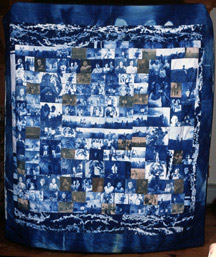
Cambodia - Photographs from a collaborative Service Learning Trip I co-led to Cambodia where we worked with non-profits including teaching art at a small alternative village school and an orphanage.
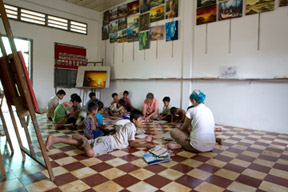
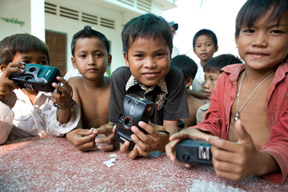
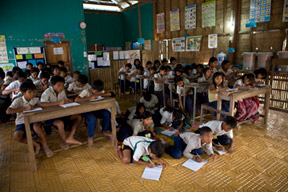
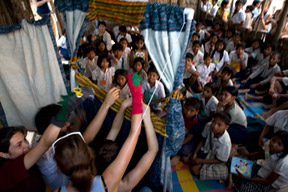
Nursing home - Images from a course I taught at the Linden Lodge Nursing Home in Brattleboro Vermont


